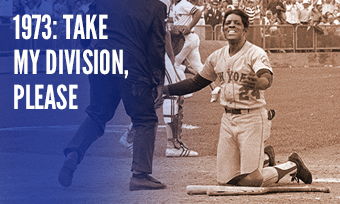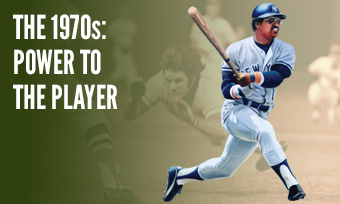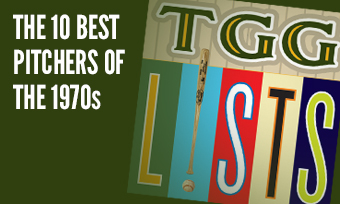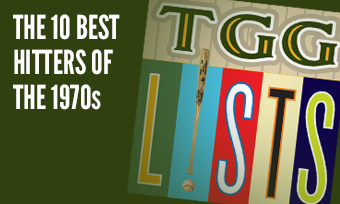The Yearly Reader
Leaders and Honors, 1973
Our list of baseball’s top 10 hitters and pitchers in both the American League and National League for the 1973 baseball season, as well as the awards and honors given to the game’s top achievers of the year.
The National League’s Top 10 Hitters, 1973
Bold type in brick red indicates league leader.
1. Willie Stargell, Pittsburgh
Key Numbers: .299 average, 106 runs, 43 doubles, 44 home runs, 119 RBIs, 80 walks, 22 intentional walks, .646 slugging percentage.
Stargell’s 44 homers included his second tape-measure shot completely hit out of Los Angeles’ Dodger Stadium; no one else would do it once until Mike Piazza in 1997.
2. Bobby Bonds, San Francisco
Key Numbers: .283 average, 131 runs, 182 hits, 34 doubles, 39 home runs, 96 RBIs, 87 walks, 148 strikeouts, 43 stolen bases.
Now firmly settled in as Willie Mays’ heir in San Francisco, Bonds came oh-so-close to becoming baseball’s first 40-40 man; he homered only once over his last 21 games.
3. Joe Morgan, Cincinnati
Key Numbers: .290 average, 116 runs, 35 doubles, 26 home runs, 82 RBIs, 111 walks, 67 stolen bases.
Strangely, Morgan hit only .252 at home—but did bat .326 on the road at the five NL West ballparks.
4. Darrell Evans, Atlanta
Key Numbers: .281 average, 114 runs, 25 doubles, 8 triples, 41 home runs, 104 RBIs, 124 walks.
Part of the first trio of teammates (along with Hank Aaron and Davey Johnson) to each belt 40 homers in one year, Evans’ total eventually stuck out as a spike of power within his typical 20-some-odd dingers per year; he’d hit 40 again, but not until 1985 for Detroit—at age 38.
5. Hank Aaron, Atlanta
Key Numbers: 120 games, .301 average, 392 at-bats, 84 runs, 40 home runs, 96 RBIs.
Closing in on Babe Ruth—and his 40th birthday—Aaron went to bat in 1973 with just one thing on his mind: Going deep. He became the first player to hit 40 in less than 400 at-bats, something that wouldn’t be achieved again until Barry Bonds—Aaron’s successor for the all-time home run crown—in 2003.
6. Pete Rose, Cincinnati
Key Numbers: .338 average, 680 at-bats, 115 runs, 230 hits, 36 doubles, 8 triples, 5 home runs, 64 RBIs, 10 stolen bases.
Pete Rose never had more hits than in 1973, while scoring his third (and last) batting title. He edged out Willie Stargell for his only MVP honor.
7. Ken Singleton, Montreal
Key Numbers: 162 games, .302 average, 100 runs, 169 hits, 26 doubles, 23 home runs, 103 RBIs, 123 walks, 27 grounded into double plays, .425 on-base percentage.
The Mets were happy to have Rusty Staub—anyone he ever played for was happy—but to get him, they gave away Singleton, who in 1973 accomplished the triple-triple (100-plus runs, RBIs and walks).
8. Cesar Cedeno, Houston
Key Numbers: 139 games, .320 average, 86 runs, 168 hits, 35 doubles, 25 home runs, 70 RBIs, 56 stolen bases.
Xeroxed Astro: Cedeno exactly matched his numbers in batting average and games played from the year before, while stealing just one more base.
9. Tony Perez, Cincinnati
Key Numbers: .314 average, 177 hits, 33 doubles, 27 home runs, 101 RBIs, 74 walks.
In the shadows of Rose, Joe Morgan and Johnny Bench, Perez continued to be the unsung hero in Cincinnati, bouncing back after a couple years of relatively modest output.
10. Lou Brock, St. Louis
Key Numbers: .297 average, 110 runs, 193 hits, 29 doubles, 8 triples, 7 home runs, 63 RBIs, 71 walks, 70 stolen bases, 20 caught stealing.
Brock stole 50 of his 70 bases from July 3 on, showing off an increasingly brazen penchant for base thefts after turning 34; he would turn it up even more, to record-setting heights, the next season.
The American League’s Top 10 Hitters, 1973
1. Reggie Jackson, Oakland
Key Numbers: .293 average, 99 runs, 28 doubles, 32 home runs, 117 RBIs, 76 walks, 22 stolen bases, .531 slugging percentage.
Rebounding from a torn hamstring suffered in the 1972 ALCS, Jackson was the unanimous choice for what would be his only MVP—and also took similar honors for the World Series, though it wouldn’t be his only trophy collected there.
2. John Mayberry, Kansas City
Key Numbers: .278 average, 87 runs, 26 home runs, 100 RBIs, 122 walks, 17 intentional walks, .417 on-base percentage.
The second-year Royal probably would have gotten a few of Reggie’s first-place votes had he not slowed down after a sparkling first half (.302 average, 19 home runs, 74 RBIs).
3. Rod Carew, Minnesota
Key Numbers: .350 average, 98 runs, 203 hits, 30 doubles, 11 triples, 6 home runs, 62 RBIs, 41 stolen bases.
Carew finally began to put some muscle on his numbers after years of hitting just above .300—and little else.
4. Sal Bando, Oakland
Key Numbers: 162 games, .287 average, 97 runs, 170 hits, 32 doubles, 29 home runs, 98 RBIs, 82 walks.
The A’s ironman—he only missed 18 games in the team’s first six years at Oakland—had one of his strongest years yet; his 32 doubles are the lowest by an AL leader in a non-shortened season.
5. George Scott, Milwaukee
Key Numbers: .306 average, 98 runs, 185 hits, 30 doubles, 24 home runs, 107 RBIs.
The Brewers, after a surprisingly good first half, slipped afterward in the standings—but Scott kept it from being a freefall by hitting .341 with 16 of his 24 homers over the final three months.
6. Reggie Smith, Boston
Key Numbers: 115 games, .303 average, 79 runs, 21 home runs, 69 RBIs, 68 walks.
A series of maladies kept the eighth-year Red Sock from pushing up strong numbers that would have elevated him into the MVP discussion; it would be his final year in Boston, and Smith—affected by racism from the front office and fans—was only too happy to depart.
7. Amos Otis, Kansas City
Key Numbers: .300 average, 90 runs, 175 hits, 26 home runs, 93 RBIs, 13 stolen bases.
After Reggie Jackson, Otis received the second most AL MVP votes among position players.
8. Carl Yastrzemski, Boston
Key Numbers: .296 average, 82 runs, 25 doubles, 19 home runs, 95 RBIs, 105 walks.
After being mired in the mid-.200s with limited power the previous two years, Yaz put forth a dignified comeback.
9. Frank Robinson, California
Key Numbers: .266 average, 85 runs, 29 doubles, 30 home runs, 97 RBIs, 82 walks, 10 hit-by-pitches.
The advent of the designated hitter was perfectly timed for the 38-year-old Robinson, who hit 26 of his 30 home runs from that ‘position.’
10. Dave May, Milwaukee
Key Numbers: .303 average, 96 runs, 189 hits, 25 home runs, 93 RBIs.
A career-year wonder, May helped the Brewers reach a high-enough level of acceptance within Milwaukee to finally exercise the irritable ghosts of the Braves.
The National League’s Top 10 Pitchers, 1973
1. Tom Seaver, New York
Key Numbers: 2.08 ERA, 19 wins, 10 losses, 36 starts, 18 complete games, 290 innings, 63 walks, 251 strikeouts.
Seaver won five less games than league leader Ron Bryant, but would have won five more had the Mets hit anywhere as good as the Giants; hence, he was given the NL Cy Young Award.
2. Don Sutton, Los Angeles
Key Numbers: 2.42 ERA, 18 wins, 10 losses, 33 starts, 256.1 innings, 57 walks, 23 grounded into double plays.
For once, Sutton was the best of the Dodgers’ five-man rotation. The only team he finished below .500 against? The Reds (1-3 in six starts), who finished 3.5 games ahead of Los Angeles.
3. Jerry Koosman, New York
Key Numbers: 2.84 ERA, 14 wins, 15 losses, 35 starts, 263 innings, 25 grounded into double plays.
Koosman won his first five decisions and six of his last seven; in between, he was 3-14. Reason? The Mets averaged only 1.4 runs when he didn’t win.
4. Jack Billingham, Cincinnati
Key Numbers: 3.04 ERA, 19 wins, 10 losses, 40 starts, 7 shutouts, 293.1 innings, 10 hit-by-pitches, 10 wild pitches, 32 grounded into double plays.
The “other” guy in the trade that brought Morgan to the Reds two years earlier, Billingham became a rare workhorse within Sparky Anderson’s share-the-wealth pitching mindset.
5. Dock Ellis, Pittsburgh
Key Numbers: 3.05 ERA, 12 wins, 14 losses, 28 starts, 192 innings.
File this under “It Doesn’t Make Sense:” Ellis evenly split his 12 wins between home and away—but his 1.58 ERA at Three Rivers Stadium was considerably better than what it was on the road (4.72).
6. Mike Marshall, Montreal
Key Numbers: 2.66 ERA, 14 wins, 11 losses, 31 saves, 12 blown saves, 92 appearances, 0 starts, 179 innings, 12 wild pitches.
Marshall was becoming ironman Wilbur Wood’s bullpen equal as a tireless reliever—and he was still just warming up.
7. Steve Rogers, Montreal
Key Numbers: 1.54 ERA, 10 wins, 5 losses, 17 starts, 134 innings.
Arguably the best pitcher in Montreal Expos history—certainly the most productive—hit the mound running; he threw two shutouts in his first three starts, the first of which was a one-hitter.
8. Jim Rooker, Pittsburgh
Key Numbers: 2.85 ERA, 10 wins, 6 losses, 5 saves, 41 appearances, 18 starts, 170.1 innings.
After four miserable years in Kansas City (21-44 record, 3.93 ERA), Rooker came to Pittsburgh and thrived as a late-season starter, filling the void left behind by a suddenly wild Steve Blass.
9. Ron Bryant, San Francisco
Key Numbers: 3.53 ERA, 24 wins, 12 losses, 41 appearances, 39 starts, 270 innings, 115 walks, 12 wild pitches.
Bryant flourished as he kept a giant stuffed teddy bear in the dugout for good luck; too bad it wasn’t around when he suffered a freak swimming injury the following spring that sank his career.
10. Don Gullett, Cincinnati
Key Numbers: 3.51 ERA, 18 wins, 8 losses, .692 win percentage, 2 saves, 45 appearances, 30 starts, 228.1 innings.
After suffering through his only losing season (9-10) the year before and struggling so badly to start the 1973 campaign that he got demoted to the bullpen, Gullett firmly found himself back on track in July—winning his last nine decisions.
The American League’s Top 10 Pitchers, 1973
1. Jim Palmer, Baltimore
Key Numbers: 2.40 ERA, 22 wins, 9 losses, .710 win percentage, 1 save, 38 appearances, 37 starts, 6 shutouts, 296.1 innings, 113 walks, 22 grounded into double plays.
Palmer capped a five-year 99-42 record by nabbing his first Cy Young Award.
2. Bert Blyleven, Minnesota
Key Numbers: 2.52 ERA, 20 wins, 17 losses, 40 starts, 25 complete games, 9 shutouts, 325 innings, 67 walks.
For the only time in a long and winding career that would eventually lead to Cooperstown, Blyleven won 20 games.
3. Ken Holtzman, Oakland
Key Numbers: 2.97 ERA, 21 wins, 13 losses, 40 starts, 297.1 innings, 66 walks, 28 grounded into double plays.
Here’s one of the reasons that the A’s were so damn good in the early 1970s; once opponents managed to get past the commanding Catfish Hunter and flashy Vida Blue, they next had to get past the underrated Holtzman, who quietly netted 21 wins in his second year at Oakland.
4. John Hiller, Detroit
Key Numbers: 1.44 ERA, 10 wins, 5 losses, 38 saves, 4 blown saves, 65 appearances, 125.1 innings.
Barely two years removed from a heart attack, Hiller put forth a spectacular campaign and became the latest reliever to break the season saves record. Comeback Player of the Year, indeed.
5. Bill Lee, Boston
Key Numbers: 2.75 ERA, 17 wins, 11 losses, 1 save, 38 appearances, 33 starts, 284.2 innings, 33 grounded into double plays.
Lee was not to be confused with the Bill Lee who starred for the Cubs during the 1930s; in fact, with a goofy (and often very sharp) wit that earned him the nickname Spaceman, he was not to be confused with anyone.
6. Jim Colburn, Milwaukee
Key Numbers: 3.18 ERA, 20 wins, 12 losses, 1 save, 43 appearances, 36 starts, 314.1 innings. 29 grounded into double plays.
The Dave May of the Brewers’ pitching staff, Colburn quickly emerged from standard bullpen asset to team ace, making him the most unlikely of the American League’s dozen 20-game winners in 1973.
7. Mel Stottlemyre, New York
Key Numbers: 3.07 ERA, 16 wins, 16 losses, 38 starts, 273 innings, 38 grounded into double plays.
The unluckiest great pitcher in Yankees history, Stottlemyre had one last solid year before suffering a career-ending rotator cuff injury—just as George Steinbrenner was starting to assert himself and breed a winning attitude back to Yankeeland.
8. Wilbur Wood, Chicago
Key Numbers: 3.46 ERA, 24 wins, 20 losses, 49 appearances, 48 starts, 359.1 innings, 31 stolen bases allowed, 32 grounded into double plays.
The throwback workhorse became the first pitcher since Walter Johnson in 1916 to both win and lose 20 games in the same season—but after a terrific start (13-3, 1.71 ERA after May), the exhaust of working every four or even three days began to catch up to him.
9. Nolan Ryan, California
Key Numbers: 2.87 ERA, 21 wins, 16 losses, 1 save, 41 appearances, 39 starts, 26 complete games, 326 innings, 162 walks, 383 strikeouts, 15 wild pitches, 37 stolen bases allowed, 24 grounded into double plays.
Ryan’s eye-popping campaign included a record number of strikeouts and two no-hitters; though he never won a Cy Young Award, he came closest in 1973, finishing a not-so-distant second to Jim Palmer in the vote.
10. Dave McNally, Baltimore
Key Numbers: 3.21 ERA, 17 wins, 17 losses, 38 starts, 266 innings, 19 caught stealing/picked off, 31 grounded into double plays.
McNally’s strikeout total, which peaked at over 200 five years earlier, was now down to 87 over 266 innings—but he remained difficult to beat.









